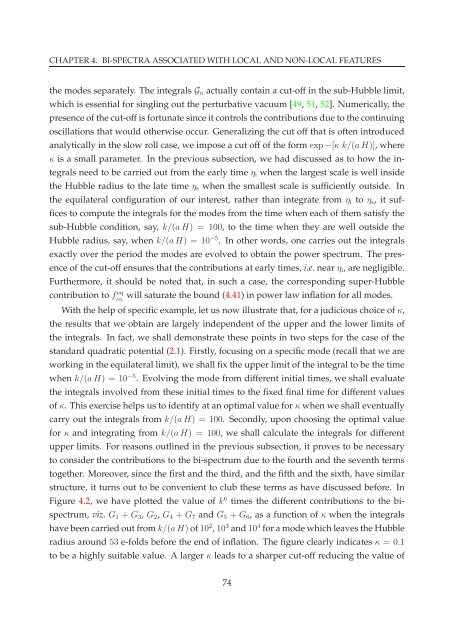PHYS08200605006 D.K. Hazra - Homi Bhabha National Institute
PHYS08200605006 D.K. Hazra - Homi Bhabha National Institute
PHYS08200605006 D.K. Hazra - Homi Bhabha National Institute
Create successful ePaper yourself
Turn your PDF publications into a flip-book with our unique Google optimized e-Paper software.
CHAPTER 4. BI-SPECTRA ASSOCIATED WITH LOCAL AND NON-LOCAL FEATURES<br />
the modes separately. The integrals G n actually contain a cut-off in the sub-Hubble limit,<br />
which is essential for singling out the perturbative vacuum [49, 51, 52]. Numerically, the<br />
presence of the cut-off is fortunate since it controls the contributions due to the continuing<br />
oscillations that would otherwise occur. Generalizing the cut off that is often introduced<br />
analytically in the slow roll case, we impose a cut off of the form exp−[κ k/(aH)], where<br />
κ is a small parameter. In the previous subsection, we had discussed as to how the integrals<br />
need to be carried out from the early time η i when the largest scale is well inside<br />
the Hubble radius to the late time η s when the smallest scale is sufficiently outside. In<br />
the equilateral configuration of our interest, rather than integrate from η i to η s , it suffices<br />
to compute the integrals for the modes from the time when each of them satisfy the<br />
sub-Hubble condition, say, k/(aH) = 100, to the time when they are well outside the<br />
Hubble radius, say, when k/(aH) = 10 −5 . In other words, one carries out the integrals<br />
exactly over the period the modes are evolved to obtain the power spectrum. The presence<br />
of the cut-off ensures that the contributions at early times, i.e. nearη i , are negligible.<br />
Furthermore, it should be noted that, in such a case, the corresponding super-Hubble<br />
contribution to f eq will saturate the bound (4.41) in power law inflation for all modes.<br />
NL<br />
With the help of specific example, let us now illustrate that, for a judicious choice ofκ,<br />
the results that we obtain are largely independent of the upper and the lower limits of<br />
the integrals. In fact, we shall demonstrate these points in two steps for the case of the<br />
standard quadratic potential (2.1). Firstly, focusing on a specific mode (recall that we are<br />
working in the equilateral limit), we shall fix the upper limit of the integral to be the time<br />
when k/(aH) = 10 −5 . Evolving the mode from different initial times, we shall evaluate<br />
the integrals involved from these initial times to the fixed final time for different values<br />
ofκ. This exercise helps us to identify at an optimal value forκwhen we shall eventually<br />
carry out the integrals from k/(aH) = 100. Secondly, upon choosing the optimal value<br />
for κ and integrating from k/(aH) = 100, we shall calculate the integrals for different<br />
upper limits. For reasons outlined in the previous subsection, it proves to be necessary<br />
to consider the contributions to the bi-spectrum due to the fourth and the seventh terms<br />
together. Moreover, since the first and the third, and the fifth and the sixth, have similar<br />
structure, it turns out to be convenient to club these terms as have discussed before. In<br />
Figure 4.2, we have plotted the value of k 6 times the different contributions to the bispectrum,<br />
viz. G 1 + G 3 , G 2 , G 4 + G 7 and G 5 + G 6 , as a function of κ when the integrals<br />
have been carried out fromk/(aH) of10 2 ,10 3 and10 4 for a mode which leaves the Hubble<br />
radius around 53 e-folds before the end of inflation. The figure clearly indicates κ = 0.1<br />
to be a highly suitable value. A larger κ leads to a sharper cut-off reducing the value of<br />
74
















